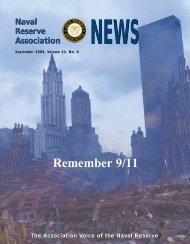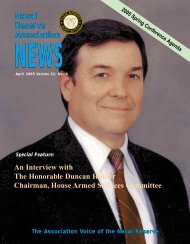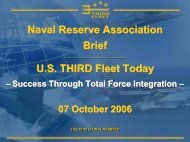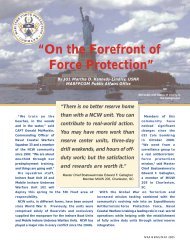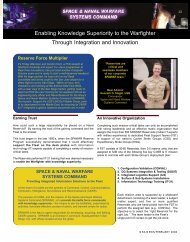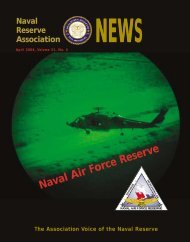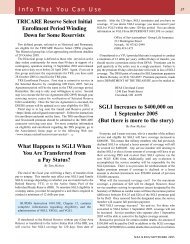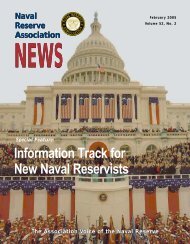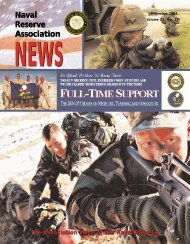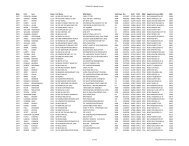Naval Reserve Association Naval Reserve Association
Naval Reserve Association Naval Reserve Association
Naval Reserve Association Naval Reserve Association
You also want an ePaper? Increase the reach of your titles
YUMPU automatically turns print PDFs into web optimized ePapers that Google loves.
15<br />
NCWG-1 Future<br />
Organization<br />
All the units, and most of their assigned Reservists, have been<br />
mobilized at one time or another for force-protection missions all<br />
over the world since the October 2000 attack on the USS COLE.<br />
The <strong>Reserve</strong> NCW community is organized into three kinds of<br />
units – Harbor Defense Commands, Mobile Inshore Undersea<br />
Warfare Units, and Inshore Boat Units.<br />
A Harbor Defense Command is a command-and-control unit<br />
linked to theater commanders.<br />
MIUW Units use surveillance equipment to watch for intruders<br />
trying to slip into port by boat or swimmers lurking underwater.<br />
The new baseline system consists of an upgraded AN/TSQ-108A<br />
Radar Sonar Surveillance Center (RSSC) van with a Portable<br />
Sensor Platform (PSP), a Mobile Sensor Platform (MSP), and a<br />
lightweight, small-boat deployable, underwater sensor string. In<br />
addition, each van has a Readiness Trainer System.<br />
The MSP is a sensor platform built onto a HMMWV to permit<br />
rapid deployment and maximum site flexibility. The remote<br />
sensors consist of a Thermal Imaging Sensor (TIS) and a Visual<br />
Imaging Sensor (VIS) [co-located on a computer-controlled pan<br />
and tilt mechanism] and a Furuno X-Band surface search radar<br />
with a CEA radar track processor system. Telemetry of radar data<br />
and imagery is sent back to the van over a 10 Km line-of-sight<br />
distance by a microwave transceiver with capability for future<br />
upgrades to fiber-optic cable. A stand-alone controller provides<br />
on-site operation if needed.<br />
The RSSC van has been upgraded to a V3 configuration. The<br />
new RSSC contains sensor-processing hardware [including an<br />
upgraded AN/SQR-17A(V)3 acoustic processor, an ESM system,<br />
and a Furuno/CEA radar system] as well as upgrades to the<br />
communications suite including Global Command Control<br />
System – Maritime (GCCS-M) network access, Fleet Broadcast,<br />
and PC-Based message management. A trailer-based PSP<br />
permits remoting of most antennas and emitters up to 150 feet<br />
away from the van if needed.<br />
Information from all the sensors is displayed via the Graphical<br />
Data Fusion System (GDFS). The GDFS is a software program<br />
that correlates all sensor information and overlays it onto a<br />
digitized map. On a single 19” screen display, operators can see<br />
the geographic picture, their own location, the location of the<br />
sensors, and target tracks. There are two GDFS workstations in<br />
the upgraded van, each with its own set of video monitors for<br />
display of the TIS and VIS images transmitted from MSPs.<br />
The display is user friendly, with scaleable maps, pop-up<br />
windows for sensor control and calibration, target icons using<br />
NTDS symbology, and selectable zones of target acquisition and<br />
noninterest. If desired, the actual radar video from one or all of<br />
the radars can be underlaid onto the display. Target data can be<br />
stored, replayed, and selectively routed into case files or into<br />
GCCS-M.<br />
Set up on shore, the MIUW communicates with an IBU, a unit<br />
consisting of six heavily armed patrol boats that serve as an<br />
interdiction force for any identified threat. IBUs also coordinate<br />
their efforts with Coast Guard Port Security Units.<br />
Since the attack on the COLE, every unit within <strong>Naval</strong> Coastal<br />
Warfare Group ONE in San Diego and about 1,600 Reservists<br />
have been mobilized. About 250 of those drilling Reservists have<br />
been mobilized twice. Reservists from Group ONE first served<br />
overseas in Bahrain, then guarded West Coast ports after 11 Sept.<br />
2001. The buildup of forces for Operation Iraqi Freedom, in<br />
December 2002, brought a large presence of NCW units and<br />
Reservists to Kuwait and, then, to Iraq, a presence that continues.<br />
For the ongoing force rotation, the latest mobilizations sent 225<br />
Reservists from the Group’s HDC 111, MIUW 103, and MIUW<br />
104 to Kuwait, replacing 225 coming home. Mobilized from the<br />
East Coast, the Reservists of <strong>Naval</strong> Coastal Warfare Group TWO<br />
have been just as busy.<br />
NRA NEWS/AUGUST 2004



